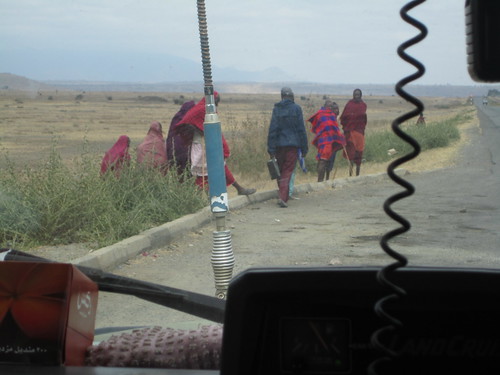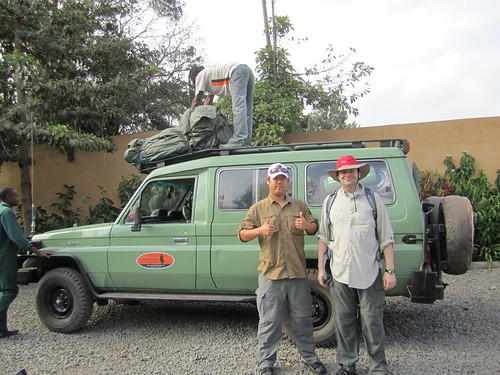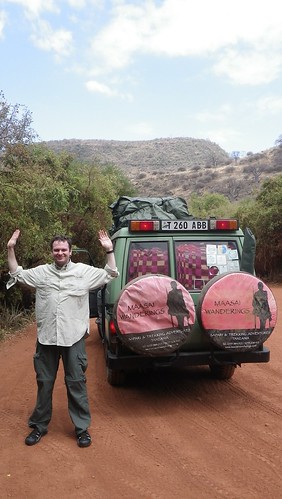Thanks everyone for the birthday wishes. Only one more year before I can run for Prez!
Ginger, all your questions concerning the climb will be answered in due course.
Stephanie, it was very uncomfortable and surreal when he started singing.
Grunge thought the shakedown sounded suspiciously like a kidnapping. While that is, of course, possible, Tanzania is not really considered a hotbed of kidnapping. Tanzania overall does have a fair amount of crime, but most of it is petty crime, although violent crime is on the rise. The airport itself, however, is guarded and gated, and only tour operators and registered taxi drivers can enter. So, at the Arusha airport anyways, kidnapping and bag snatching would be rather difficult.Back to the story...

... we begin with a picture of David. David was our tour guide for the safari. David is an awesome tour guide. If you go to Tanzania and want a guaranteed amazing safari experience, you should hire David.
David is a member of the Chagga tribe, and like most of the Chagga people, grew up literally on or around the slopes of Kilimanjaro. As I stated before, Tanzania has over 120 tribes, of which the Chagga is one of the largest, having an estimated 2 million members. When you visit northern Tanzania, the vast majority of your interactions will be with Chaggas. To explain why, you have to delve a bit into African mythology. I am sure I will butcher it, but it goes something like this:
When God made the world, he made many tribes. And to each of these tribes he gave a special gift. To the Chagga, he gave a keen business acumen.So, even though most of the Chagga live around Kilimanjaro, if you visit other cities in Tanzania, the businesses there will be disproportionately run by Chagga.


When you think of Tanzania, however, you don't think of Chagga. You think of the Maasai. The Maasai number about a million people, evenly split between Tanzania and Kenya. However, that number is a complete guess. This because the Maasai are a nomadic herding people, mostly raising cows. Continuing with the mythology, it is said that the Gods gave the cow to the Maasai. At some points in Tanzanian history, this created problems, because the Maasai would take cows owned by non-Maasai. This was not done maliciously. After all, since God gave cows to the Maasai, you did not really own your cow, and so they were just taking what was rightfully theirs. They don't do this anymore, but the Maasai are still a fascinating people who we will explore in future installments.
Which brings us to our outfitter, and David's employer: Maasai Wanderings.


As you can see, this is also probably the first ever appearance of Cornholio in Africa.
When we were looking for outfitters, well, we were pretty clueless. We had some recommendations here and there, but I wanted a more objective way to evaluate them. Which is when I stumbled onto the Kilimanjaro Porter Assistance Project (KPAP). For those who don't know what porters are, they are the people who carry all the equipment as you climb mountains (to be distinguished from Sherpas, which is technically a tribe name, in the Himalayas).
Now, when choosing an outfitter, we had two main competing concerns: cost and everything else. On the one hand, the logistics of an Africa trip are expensive (more on the specifics of why later). On the other hand, you want everything to go smoothly in an unfamiliar part of the world.
Which brings us back to the porters. Porters are a touchy subject. On the one hand, it provides decent paying employment for unskilled labor. On the other hand, because there is a glut of unskilled labor, some tour operators can afford to treat them like crap, providing less-than-subsistence pay, insufficient equipment, and dangerous working conditions.
The bleeding-heart liberal in me found "the other hand" unacceptable, but there was also several non-empathetic arguments to be made as well. For example, do you really want to put your lives in the hands of people who are under-paid and under-equipped? Under-paid porters are more reliant on tips, and so they have been known to be more aggressive about asking for tips, to the point where it is not unheard of to hold your equipment hostage until you pay them. Under-paid porters have also been known to moonlight on several trekking groups simultaneously, creating problems. And if the company is willing to skimp on pay to their porters (KPAP recommends the "absurd" sum of 6 dollars per day), what else are they willing to skimp on? And like everything else, wouldn't the better porters gravitate toward the higher paying companies?
So given all this, the question remained of how to minimize cost, but also "the other hand?"
The compromise I came up with was KPAP (or IMEC). A non-profit, KPAP certifies that its member companies meet certain minimum ethical and financial standards with regards to the treatment of their porters. Now, you may ask "how do you know all this isn't just a bunch of hooey?" The answer is, I guess I don't. But between having something to go on, and nothing to go on, I went with the something to go on. Sue me.
So, I basically went down the list of KPAP's partner companies and e-mailed everyone asking for quotes on a four-day safari and seven-day Kili trek (more on how we arrived on those numbers in a future post). For comparison purposes, I also e-mailed some companies I found in books. About 25 companies, or half, had intelligible responses.
By far the highest response rate was from U.S. and U.K. companies. They also had by far the highest quotes, ranging from $4,000 per person to $7,000 per person for the whole package. While there was an appeal to dealing with Western-based companies with Western business standards, their pricing immediately knocked them out of contention.
The response rates for on-the-ground Tanzanian companies was way lower, but so was their pricing, ranging from a low of $2,200 per person to a high of $3,900 per person. The KPAP companies, however, were definitely higher, on the order of about $500 for comparable itineraries, so that gave me confidence that yes, the KPAP label does indeed mean "something."
From there, I narrowed the choices down to three companies in the $2,700 to $3,000 range, and proceeded to apply a finer filter to them. After some deliberations, I decided on Maasai Wanderings for several reasons.
First, my primary contact was Donna, an Australian native who fell in love with and married a Tanzanian. She and her husband run the company. While the fact that she is a Westerner, by itself, makes no difference, her upbringing in Australia meant that she knew the level of customer service Westerners expected. My e-mails to her were returned in a very timely manner, thoroughly answered all of my questions, and she had no problems making adjustments on the fly. It was light years ahead of all the other companies. This was, by far, one of the biggest factors in their favor.
Second, her company plows some of its profits into local community projects, mostly schools for Maasai children. While I suppose this could be a front to lure unsuspecting rubes like myself, one option they offer are visits to their various projects. So, either they actually do run the schools, or they pay a bunch of Maasai children to pretend they attend these schools. I figured I could live with either scenario, so that was also a plus.
Third, and this was more of an after-the-fact thing, they accepted Paypal. None of the Tanzanian-based companies take credit cards, checks, money orders, etc. They all either require cash when you get there, or wire transfers. Now, I don't know about you, but I wasn't looking forward to carrying four figures in cash into Africa (and ATM limits made that option impractical), and my lack of familiarity with wire transfers made me uncomfortable. So, despite the fact that I had to pay extra transaction fees, I felt the backing of a U.S. credit card and Paypal made the it worth it.
Some people have "heard" that it's cheaper to get an outfitter once you land in Africa. After viewing the situation on the ground, however, I don't believe this is the case. Basically, your trip is going to cost, at minimum, about $200 per person, per day. Sounds suspiciously high for a cheap continent right? Well, the first thing you have to understand is that park fees alone will run $100 per person, per day. You heard that right, $100. You are correct that Tanzania is a poor country, which is why they jack high fees on tourists who presumably can afford the fees if they are spending the dough to come all the way to East Africa (by comparison, park fees for natives are only about $5, but consider their per capita GDP is only $1,400, 169th in the world). So, if fees are $100 per day, everything else costs $100 per day. On safari, that means vehicle, gas, food, accommodations, guide, and chef. On trek, that means equipment, guides, porters, water, and food. $100 per person, per day sounds much more reasonable now doesn't it? In fact, I can't imagine what corners would need to be cut to get under $100, so ask yourself, is the extra $20 really worth it?
The conclusion? There isn't much room for a company to go lower, even if you book them after arriving in Africa, so give yourself peace of mind, and book ahead of time. If anything, you will lose a day or two trying to find an outfitter, and so any "savings" will easily be eaten up by hotel fees.
Okay, enough boring stuff. Back to the safari.





Our first stop was Lake Manyara National Park, which is about two hours outside of Arusha. Having settings described by Hemingway as "the loveliest I have seen in Africa," Manyara is particularly known for its birds (especially flamingos) and tree-climbing lions.

Lake Manyara is a part of the Great Rift Valley, an imposing geological formation that stretches from Mozambique to Jordan, and that will one day (millions of years from now) form an ocean.

The nature center and signs identifying some of the birds in the park, while we waited for David to get our permits...


... and we were off. Now, most of our viewings were done through the "sunroof" of the Land Rover. About 90% of the safari vehicles we saw were Toyota Land Cruisers. Here are pictures of Resha and Bill through this "pop-top," as well as one down through the pop-top into the vehicle.



One regulation, for better or for worse, was that you had to stay in the vehicle at all times in National Parks, except for certain designated areas, mostly lunch areas. But this wasn't really a problem, as you will see.
A view of the vehicle behind us viewing animals.

As this was our first safari experience, we didn't really know what to expect, particularly with regards to how many animals we would see. While everyone advertised animals as far as the eye could see, would this really be the case? After all, when you go to places like Shenandoah or Yosemite, which are famous for bears, your chances of seeing them are still pretty small.
Our question was partially answered when not ten minutes into our safari, we saw a family of blue monkeys.

But still, that was small potatoes. Kind of like seeing squirrels back home. Fortunately, some big game appeared less than ten minutes later. An elephant. A big one.

Of course, this is very, very, VERY far away. Now, we were happy to see one of the Big Five (or Big Six, depending on how you are counting), but were they so scared of people that they would keep their distance? Kind of loses it's effect. Luckily, this question was answered very rapidly as well, as the elephant started coming down...

... and down...

... and even further down...

... until he was in the road. And close. How close you may ask? This close...



... so close, that we got these detailed pictures...


... and that answers that about how scared they were. Which brings us to Rex.

Now, Resha had been taking a stained glass art class prior to leaving for Africa. Specifically, she had been making a giraffe, which she named Rex. So naturally, when she saw her first giraffe, we had to name it Rex. More pictures of Rex.



Resha and Rex.

Rex enjoying the view with his buddy.

Cornholio and the boyz.

What you lookin' at!

Well, I think that's enough excitement for one day. Going to bed. Until next week...
This is incredible stuff, Mike. Happened across this posting in my facebook newsfeed. Glad I did. Great writing and awesome shots. Travel safe!
ReplyDeleteDisch